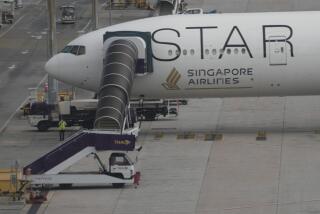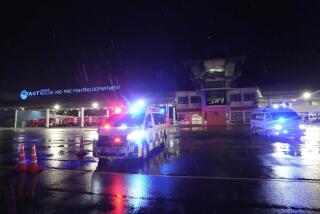Missing Malaysia plane inquiry focuses on the 239 on board
BEIJING — Like an Agatha Christie whodunit, the investigation of the disappearance of Malaysia Airlines Flight 370 is now focusing on a finite circle of suspects: the 227 passengers and 12 crew members of the missing plane.
While loath to call it a hijacking, Malaysian officials say they believe someone on the plane with expertise in the navigational and communications systems of the Boeing 777 diverted it from its Kuala Lumpur-to-Beijing flight path.
“In view of this latest development, Malaysian authorities have refocused their investigation into the crew and passengers on board,” Malaysian Prime Minister Najib Razak said at a news conference Saturday. But, he said, “despite media reports that the plane was hijacked, I wish to be very clear we are still investigating all possibilities for what led ... Flight 370 to deviate from its flight path.”
U.S. investigators appeared to be focusing Saturday on a failed-hijacking theory, renewing their background checks on the passengers and crew.
Thus far they have turned up no evidence of any “traditional” Islamic terrorist link to the plane’s disappearance. But they remain intrigued about who might have diverted the jumbo jet westward from its planned course.
“This is feeling like kind of a failed hijacking,” a federal law enforcement official said, speaking anonymously because the investigation was ongoing.
He said U.S. authorities theorized that once the plane was diverted toward the Indian Ocean, it was flown erratically at high altitudes in an attempt to depressurize the cabin and render the passengers unconscious. “That could have neutralized any threat from them to take the plane back,” he said.
“Indicators suggest it was a deliberate incident, not equipment failure,” said Tom Captain, principal and vice chairman of the aerospace and defense practice at financial advisory firm Deloitte. “It’s hard to see how a passenger could get in the cockpit without distress signals sent from the crew.”
Among those who are coming under investigation are pilot Zaharie Ahmad Shah, 53, one of the airline’s most seasoned pilots, described by Malaysian newspapers as an “aviation geek” who owned a flight simulator at home and flew remote-control airplanes and helicopters as a hobby.
Copilot Fariq Abdul Hamid, 27, with the airline since 2007, had been the subject of speculation because of a 2011 incident in which he invited two South African women into the cockpit during a flight, where the women said he flirted with them, smoked cigarettes and posed for photographs.
Local media reported that the homes of Shah and Hamid had been searched.
Since the airliner vanished a week ago, investigators have been looking at the backgrounds of two Iranian passengers traveling on stolen passports. Pouria Nour Mohammed Mehrdad, 19, was booked through to Frankfurt, Germany, where his mother awaited him. Delavar Seyed Mohammad Reza, 29, boarded the flight with Mehrdad, according to CCTV video, but had been booked to Copenhagen.
Investigators have said the two had no known links to terrorist organizations and appeared to be economic migrants trying to reach Western Europe.
Now the rest of those on the flight have been transformed from probable victims to potential suspects. The largest number of passengers, 159, were Chinese nationals. Most of the rest were Malaysians, with a few Ukrainians, Indians, Indonesians, Australians and three Americans. U.S. expatriate Philip Wood, 51, worked for IBM; the two other Americans have been described as toddlers.
Among the Chinese were a group of artists and calligraphers returning from an exhibition celebrating the “Chinese Dream.” One was a 35-year-old ethnic Uighur, Maimaitijiang Abula from Kashgar, in western China’s Xinjiang region. He’s been singled out by the Malaysian press because of fear of violence from the Uighur separatist movement in China.
“It is important to profile all the passengers and crew. All the countries whose nationals were on that flight have to participate in the investigation so that they can narrow it down to who is responsible,” said Rohan Gunaratna, a Singapore-based terrorism expert. “It is very likely that more than one person was responsible and that there were others on the ground responsible as well.”
Malaysian and U.S. investigators have said that anyone diverting the airplane would have had to be familiar with its navigational and communications systems. The Aircraft Communications Addressing and Reporting System and transponder were switched off within 50 minutes of takeoff, at a location between Vietnam and Malaysia where radar coverage is spotty.
Some investigators speculate that the flight’s zigzag path also could have been designed to evade detection. Initially headed northeast toward Beijing, it apparently turned west over the Malacca Strait, before heading toward the Indian Ocean.
Flight 370 took off from Kuala Lumpur, the Malaysian capital, at 12.20 a.m. on March 8 and disappeared from radar about 1.30 a.m.
Malaysian authorities say satellites picked up signals from the flight until 8:11 a.m., about the time it would have run out of fuel.
“Due to the type of satellite data, we are unable to confirm the precise location of the plane when it last made contact with the satellite,” Prime Minister Najib said.
Najib said investigators were focusing their search on two arcs: one heading from Indonesia to the south Indian Ocean, the other headed over western China toward Central Asian nations such as Kazakhstan and Turkmenistan.
Aviation experts believe, however, that if the plane headed north it probably would have been picked up by India’s land-based primary radar systems or by those of other countries along the route, including Thailand and Myanmar.
“A Boeing 777 would always be picked up on primary radar coverage. It is not like a stealth bomber,” Mikael Robertsson, cofounder of FlightRadar24, which tracks about 120,000 flights per day, said in a telephone interview from Sweden. “If it flew over land, some country would have seen it on the radar. It is more likely it flew over water where it went undetected.”
State-run media in China, which sent a fleet of eight ships to search for the plane, reacted furiously to the Malaysia’s belated acknowledgment of apparent foul play.
“Given today’s technology, the delay smacks of either dereliction of duty or reluctance to share information in a full and timely manner,” the New China News Agency complained in a hard-hitting editorial. “And due to the absence — or at least lack — of timely authoritative information, massive efforts have been squandered, and numerous rumors have been spawned, repeatedly racking the nerves of the awaiting families.”
The agency also accused the United States of not being forthcoming about intelligence it had gathered about the flight.
James E. Hall, who served as chairman of the National Transportation Safety Board from 1993 to 2001, accused the Malaysian air authorities of incompetence, beginning with letting two passengers board the plane with stolen passports.
“It was clear from the beginning that this could have been a criminal act, and it took Malaysian authorities a week to conclude that,” Hall said. “It seems that whomever was responsible for taking control of this plane determined that Malaysia was the weakest link in the civil aviation system.”
Hall noted that the International Civil Aviation Organization could wrest control of the investigation from Malaysia if that nation proves incapable.
In Beijing, meanwhile, family members of passengers who watched the Malaysian prime minster’s news conference on a large-screen TV at a hotel reacted to the news of a suspected hijacking with astonishment and even a little relief.
“Do you think they might alive?” one man was overheard asking another as they waited outside the conference room.
“They could be alive,” responded another.
Times staff writers Richard A. Serrano in Washington and W.J. Hennigan in Los Angeles and Nicole Liu of The Times’ Beijing bureau contributed to this report.
More to Read
Sign up for Essential California
The most important California stories and recommendations in your inbox every morning.
You may occasionally receive promotional content from the Los Angeles Times.










